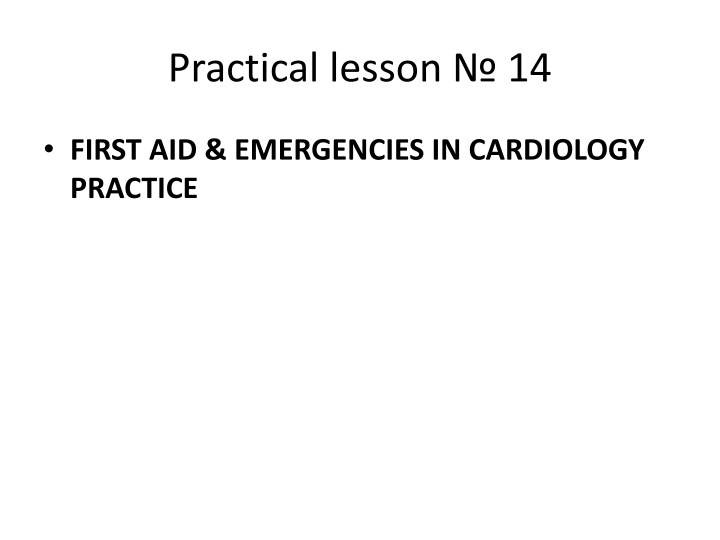
Heart Pain: Causes, Symptoms, and First Aid
Learn about heart pain, including causes like ischemic heart disease, main stages of pathogenesis, and first aid measures in emergencies like myocardial infarction and hypertensive crisis. Recognize the importance of timely pre-medical care to save lives.
Download Presentation

Please find below an Image/Link to download the presentation.
The content on the website is provided AS IS for your information and personal use only. It may not be sold, licensed, or shared on other websites without obtaining consent from the author. If you encounter any issues during the download, it is possible that the publisher has removed the file from their server.
You are allowed to download the files provided on this website for personal or commercial use, subject to the condition that they are used lawfully. All files are the property of their respective owners.
The content on the website is provided AS IS for your information and personal use only. It may not be sold, licensed, or shared on other websites without obtaining consent from the author.
E N D
Presentation Transcript
Practical lesson 14 FIRST AID & EMERGENCIES IN CARDIOLOGY PRACTICE
CONTROL QUESTION Stenocardia. Causes, main stages of pathogenesis. Clinic. First Aid (predoctor care). Myocardial infarction. Causes, main stages of pathogenesis. Clinic. First Aid (predoctor care). Left ventricular fail. Causes, main stages of pathogenesis. Clinic. First Aid (predoctor care). Hypertensive crisis. Causes, main stages of pathogenesis. Clinic. First Aid (predoctor care). Syncope. Causes, main stages of pathogenesis. Clinic. First Aid (predoctor care). Collapse. Causes, main stages of pathogenesis. Clinic. First Aid (predoctor care). PRACTICAL SKILLS Palpation of pulse. Technique of determination of the pulse on the carotid artery. Measuremen blood pressure.
FIRST AID & EMERGENCIES IN CARDIOLOGY PRACTICE Heart pain (Angina pectoris) Heart Attack (Myocardial infarction) Cardiac asthma attack Hypertensive crisis Collapse Syncope Clinical death
HEART PAIN Cardiologists say that the patient's life depends on the quality and timeliness of pre-medical and emergency care for myocardial infarction.And this means that everyone, especially patients with ischemic heart disease, should know the first signs of this acute heart pathology and the correct algorithm of actions before the arrival of an ambulance. Cardiovascular diseases that result in chest pain may be due to angina, myocardial infarction (heart attack), pericarditis or an aortic dissection. There are other possible causes, however, the presentation is usually not sudden and severe pain as it is with these conditions. Of these, angina is the most common and may occur as episodes over years before a heart attack ensues.
The main cause of heart pain -Ischemic heart disease. The cause for its development is the coronary atherosclerosis (arteries supplying blood to the heart).At the heart of the pathology is a violation of the coronary circulation, which results in oxygen starvation in the background of the physical and emotional tension of the cells of the myocardium.
Classification of coronary heart disease ACUTE FORM: myocardial infarction CHRONIC FORM: 1. angina pectoris at stress 2. angina pectoris at rest (Prinzmetal variant angina) 3. unstable angina (or crescendo angina)
Angina pectoris is one of the forms of the Ischemic heart disease. The cause for its development is the coronary atherosclerosis (arteries supplying blood to the heart). There are two types of angina pectoris depending on the circumstances by which it occurs - angina pectoris at stress and angina pectoris at rest. The angina at stress occurs in connection with physical or emotional exertion. The angina at rest is not connected with physical exertion. It occurs at night and often involves an increased shortness of breath. Angina pectoris always occurs with spasms.
ANGINA PECTORIS Mechanism of development atherosclerotic plaque or coronary artery spasm physical activity or stress increased heart rate increased myocardial oxygen need ischemia / hypoxia of myocardium Heart pain
Angina symptoms include: Complaints: The pain in angina pectoris is typically felt behind the breastbone (retrosternal) and sometimes may be more pronounced slightly to the left of the sternum. Nature of pain: Typically the pain is described as a crushing or constricting pain. Patients may also describe the pain as burning or aching or even a tightness in the chest. Severe, sharp or stabbing pain is rarely due to angina it is more likely due to conditions like pericarditis. Pain commonly radiates to the region under the left scapula, the neck, and the left arm. The duration of the attack is not more than 15 minutes Heartbeat Weakness Whiteness Objective data: patient in conscious may be pale skin (because of stress) the breath does not change as a rule tachycardia as a rule
Stenocardia. First aid: Call a physician. Individual motor regime /To ensure the patient is at rest The patient's position - orthopnea To ensure a flow of fresh air, unbutton constraining clothes. To measure pulse rate and blood pressure. If systolic BP is not less than 100 mm Hg to give 1 tablet of nitroglycerin under the tongue. If the pain is not relieved, nitroglycerin should be repeated (3 tablets at an interval of 5 minutes). Under the control of blood pressure.
Myocardial infarction Among all clinical forms of ischemic heart disease, special attention is given to myocardial infarction. It is this disease that often helps to disable, and in severe cases leads to death. In the definition of MI, timely diagnosis is important, for which the first thing to be done is the correct interpretation of the clinical picture. In particular, information about the normal work of the heart and the first signs of myocardial infarction will be useful to everyone. In some cases, this can save somebody's life, because ambulance will be called in a timely manner.
Reasons coronary circulatory disorder develops on the background of a change in the structure of the atherosclerotic plaque due to its cracking, erosion or bundle. A Under favorable circumstances, an atherosclerotic plaque begins to form on the inner surface of the coronary arteries.This formation has a fibrous tire, which can break, and then subendothelial connective tissue is in contact with blood cells and other shaped elements. In the future, platelets accumulate on the site of the damage, thrombin gradually forms, which leads to thrombosis of the vessel. nd is formed blood clot. When clogging (obturation) of the lumen of the vessel by clot, the larger or smaller portion of the myocardium ceases to supply the bloodstream, which leads first to ischemia, and then to dying (necrosis) of the tissue.
Myocardial infarction Mechanism of development Under the presence of risk factors, an atherosclerotic plaque begins to form on the inner surface of the coronary arteries atherosclerotic plaque can break due to its cracking, erosion or bundle platelets accumulate on the site of the damage, thrombin gradually forms, which leads to thrombosis of the vessel When clogging (obturation) of the lumen of the vessel by clot, the larger or smaller portion of the myocardium ceases to supply the bloodstream ischemia dying (necrosis) of the tissue
Myocardial infarction symptoms include: Complaints: Anger pain is a characteristic symptom of MI. Characterized by high intensity, located behind the sternum. Pain often spreads nerve fibers to other parts of the body - the shoulder blade, throat, abdomen, arm. The pain does not pass quickly. Her duration can range from 15 minutes to an hour or more. In the face of severe pain, patients often experience fear of death, there is a sticky sweat. Objective data: patient in conscious forced position - standing position (symptom shop window ) may be cyanosis of lips the breath does not change as a rule tachycardia as a rule, may be irregular heart rhythm blood pressure decreases
Myocardial infarction. First aid: It starts to appear even at the pre-hospital stage, when the person only felt a lot of pain, but emergency medical care has not yet arrived. Call a physician. Individual motor regime - bed rest The patient's position - orthopnea To ensure a flow of fresh air, unbutton constraining clothes. To measure pulse rate and blood pressure. If systolic BP is not less than 100 mm Hg to give 1 tablet of nitroglycerin under the tongue. Although the drug does not completely relieve pain, it can weaken the attack somewhat. If the pain is not relieved, nitroglycerin should be repeated (3 tablets at an interval of 5 minutes). Under the control of blood pressure. At the pre-hospital stage, aspirin is available in a dose of 300 mg, but at the same time the patient should not have a known allergic reaction.
Acute Left ventricular failure Acute Left ventricular failure is characterized by a sharp and sudden violation of the contractile function of the heart, namely, its decrease. Reasons: In most cases, the emergence of a similar pathology is facilitated by the occurrence of diseases that excessively strain the left side of the heart muscle. The intensity of manifestation of clinical signs will depend on the severity and form of the course of such a disease.
Mechanism of development: The contractility of the left ventricular myocardium is sharply reduced Blood overfills the left atrium that leads to the pressure increase in it. The right ventricle, preserved its working capacity, continues to pump into the pulmonary vessels all the blood received from caval veins. The left ventricle does not accommodate the whole volume of blood from the lungs. This remainder stays too long in the pulmonary circuit, as a result a hydrostatic pressure elevates in the pulmonary circuit. Blood is directed from the capillaries to alveoli Liquid-filled alveoli cease to participate in gas exchange, which leads to the to reduce lung volume.
Clinic of Acute Left ventricular failure Complaints: A strong attack of cough. It can be dry or accompanied by the release of foamy sputum separation of the foam of a pinkish hue. ttack Inspiratory dyspnea. Pronounced wheezing, published by a person during breathing. Fear of death Objective data: Patient in conscious. Patient is restless. Forced position - The patient usually sits in bed. Cyanosis of lips Noisy bubbling breath. Bubbling wheezing are well audible even at a distance from the patient. Respiration is rapid, accessory muscles are moving. Pulse is rapid and has pulses alternans characters.
Acute Left ventricular failure. First aid: 1. 2. 3. 4. Call for a physician. Help to take the forced position - orthopnea. Oxygen supply should be given. Give the patient nitroglycerin if systolic blood pressure of a patient is not less than 100 mm Hg. Legs above the knees and one arm above the elbow is desirable to rebench or put on the wiring, which will help ease the work of the heart. Instead of harnesses you can use a capron stocking or elastic bandage. When applying harnesses it is important to adhere to certain rules: fold on the legs you need to retreat down 15 cm. joint, the hands retreat down 10 cm. harness is transferred to the free limb and so in order. After 15-20 minutes, we should loosen the tourniquet. Removal of tourniquets should be carried out sequentially in slow mode (first from one limb, after a while from the other, etc.). 5. From the inguinal From the shoulder Every quarter of an hour, one 6.
Hypertensive crisis Hypertensive crisis - a sharp rise of blood pressure. In this case, the symptomatology of the defeat of the main organs the heart, lungs, brain and so on develops. This condition is very difficult and requires emergency care, because otherwise serious complications may develop. The provoking factors: Endocrine disabilities limate change; taking large doses of alcoholic beverages eating salt, more than the daily allowance Flights stress, lack of sleep.
Hypertensive crisis. Clinic: Complaints: severe headache in the occipital region dizziness visual disturbances tremors all over the body, as in a fever nausea pain can be in the heart Objective data: hyperemia of the face due to a blood flow Pulse is high volume and tension. BP above 140/90 mm Hg
Hypertensive crisis. First aid: 1. Reassure the patient and call for medical help! 2. Give the patient a comfortable position in bed. The head should be raised (put an extra pillow under his/her head), legs are down. 3. Warmth to feet (blanket or hot water bottle, you can put mustard on the calf muscles). 4. Meanwhile look for possible cause for hypertensive crisis. If the patient is a known hypertensive and missed medication, consult doctor over the phone and give a dose of medications if instructed. Give to patient an extraordinary dose of his medication under the tongue (absorbs faster).
Syndrome of acute vascular insufficiency: Fainting/Syncope Collapse Shock
Fainting/Syncope Fainting/Syncope/ Passing out / Syncopal episode is the medical term for fainting or passing out. Syncope - a brief loss of consciousness. It is caused by a temporary drop in the amount of blood that flows to the brain. The person then falls down or over, which allows blood flow to return to the brain. Returning blood flow allows the person to regain consciousness.
What causes syncope? Triggers/Causes: Syncope can be caused by an underlying medical condition or from environmental triggers. Common Triggers of syncope include: abrupt changes in posture, such as standing up too quickly, which can cause blood to pool in the feet or legs standing for long periods of time extreme pain or fear at trauma extreme stress pregnancy hunger Syncope may be a manifestation of the disease. dehydration exhaustion low blood pressure or dilated blood vessels irregular heart beat
Clinic: Complaints: Before loss of consciousness lightheadedness, nausea. Then patient settles slowly. Objective data: Consciousness not Pale skin. Shallow breathing A slow, weak pulse Blood pressure is reduced. Arterial pressure - less than mm Hg No consciousness (from several seconds to several minutes).
First Aid: 1. Lay (lower the head, raise legs), the head is turned to one side (it provides a flow of blood to the head); fresh air (open a window if the person is in a stuffy room); unbutton constraining clothes (collar, belt); spray the face with cool water Pat on the cheeks; Give the person breathe in the fumes of ammonia. You need to slightly moisten the cotton wool with ammonia, and hold it at a distance of 1-2 cm from the nose of the person). After consciousness is back, give the person strong tea with sugar. 2. 3. 4. 5. 6. 7.
Collapse Collapse - sudden exhaustion, prostration or weakness due to decreased blood circulation. Differs from syncope by longer duration and severity of events. During collapse the tonus of all blood vessels is greatly reduced, it leads to a fall of blood pressure and cardiac abnormalities. Reasons Call such a state as collapse, there are many reasons: Severe blood loss after trauma, internal bleeding. Many infectious diseases, for example, hepatitis, scarlet fever, pneumonia. In the case when the patient, lying for a long time, tries to stand up sharply. Dehydration. Electric shock. Heatstroke. The effects of ionizing radiation, especially in high doses. Poisoning by food or some medicines.
The mechanism of blood pressure formation The normal level of blood pressure in the body of a healthy person is provided by two factors: the volume of blood and the capacity of the vascular bed capacity of the vascular bed volume of blood BLOOD PRESSURE
Mechanism of development of Collapse: MAIN DISEASE Reduction of volume of blood: Reduction of capacity of the vascular bed (vasodilatation) Reduction of BLOOD PRESSURE hypoxia of the brain oppression of vital functions of an organism
Clinic of Collapse: Complaints: complaints on sharp deterioration of a person's condition. severe generalized weakness Noise in ears. In the eyes it gets dark. Objective data: disturbed consciousness The facial features are sharpened. Skin pale, and there is a cold sweat There is a bluish tint of nails, skin on the hands and feet. Breathing becomes frequent and superficial. The body temperature decreases. pulse is rapid, a thin or thready pulse, hypotension.
Collapse. First Aid: Call the ambulance. In case of such an attack, the patient should be put on his back on a flat surface. Unbutton the top buttons on the clothes, if any. In the room it is desirable to open the window to allow more fresh air. Legs can be raised slightly to increase the flow of blood to the head. Since there is a decrease in body temperature, the patient must be warmed with a warmer. Bring to the nose a tampon, soaked in ammonia.






















